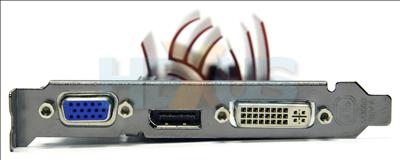The card
The reference card was supplied by AMD.Radeon HD 5450 will ship with 256MB, 512MB or 1,024MB frame buffers. Reiterating an important point made earlier, AIB partners will be free to use DDR2 or faster DDR3 memory to further differentiate models.
Due to the low-power nature of the GPUs, we imagine that all HD 5450s will be passively cooled, as per the picture above. AMD's used a half-height card that, on first glance, makes it useful for smaller HTPC chassis.
Clocked in at 650MHz core and 512MB of DDR3 at 1,600MHz, supplied by Samsung, retail examples will cost around £40, including VAT. That puts HD 5450 in-between the GeForce 210 and GT 220 GPUs from NVIDIA, and we'll be comparing performance against both. HD 5450 throttles down to 157MHz engine and 200MHz memory when running basic 2D apps.
The half-height PCB requires a ribbon to route the analogue VGA output to the port at the back. But notice the size of the heatsink?
This picture shows that the cooler will take up the slot adjacent to the PCIe x16's, meaning that it may not be useful for a few HTPCs after all. We hope that partners invest in providing a wider, squatter heatsink that takes up a single slot, as defined by the PCI plate.
AMD has chosen VGA, DisplayPort and dual-link DVI as outputs, but again, partners are free to add what they see fit. Our architectural observations indicate that the GPU will struggle once the in-game quality of recent titles is pushed up above 'low', so a selling point will be multi-monitor support under the Eyefinity branding. We can see HD 5450 as a cheap method of powering a three-display setup for increasing productivity.
Importantly, the latest iteration of the Unified Video Decoder enables the card to provide bit streaming support for high-definition codecs and dual-stream video decode (BD-Live-compliant).














